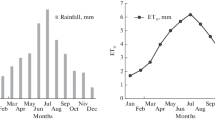Abstract
This paper presents the results of sensitivity analysis of FAO 33 method and its modified forms that were developed by Rao et al. (Agric Water Manage 13:25–32, 1988). Results show that positive error of PET and Ky and negative error of AET result in over predicting of relative yield (Yr). Sensitivity of Doorenbos and Kassam (FAO irrigation and drainage paper No. 33. FAO, Rome, Italy, 193 pp, 1979) equation (FAO 33 method) and additive form of Rao et al. (Agric Water Manage 13:25–32, 1988) equation is equal for positive or negative error of Ky and AET, but their sensitivities are greater for negative error of PET than positive error. However, sensitivity of multiplicative form of Rao et al. (Agric Water Manage 13:25–32, 1988) equation is greater for negative error of Ky and PET and positive error of AET. Error percentage on estimation of Yr by multiplicative form of Rao et al. (Agric Water Manage 13:25–32, 1988) equation arising from error of PET, AET, or Ky is less than additive form. In addition, calculated Yr by multiplicative equation is higher than additive form and the difference between two forms of this equation increases severely when water shortage increases. According to the results, it is recommended that multiplicative form of Rao et al. (Agric Water Manage 13:25–32, 1988) equation instead of additive form be used in optimization models and deficit irrigation planning.






Similar content being viewed by others
References
Allen RG, Pereira LS, Raes D, Smith M (1998) Crop evapotranspiration: guidelines for computing crop water requirements. FAO irrigation and drainage paper no. 56. FAO, Rome, Italy
Anac MS, Ali Ul M, Tuzel IH, Anac D, Okur B, Hakerlerler H (1999) Optimum irrigation scheduling for cotton under deficit irrigation conditions. In: Kirda C, Moutonnet P, Hera C, Nielsen DR (eds.) Crop yield response to deficit irrigation, Dordrecht, The Netherlands, Kluwer Academic Publishers
Dehghanisanij H, Nakhjavani MM, Tahiri AZ, Anyoji H (2009) Assessment of wheat and maize water productivities and production function for cropping system decisions in arid and semiarid regions. Irrig Drain 58:105–115
Doorenbos J, Kassam AH (1979) Yield response to water. FAO irrigation and drainage paper No. 33. FAO, Rome, Italy, 193 pp
FAO (2002) Deficit Irrigation Practices. FAO Water report NO. 22. FAO, Rome, Italy
Ghahraman B, Sepaskhah AR (2004) Linear and non-linear optimization models for allocation of a limited water supply. Irrig Drain 53:39–54
Igbadun HE, Tarimo AKPR, Salim BA, Mahoo HF (2007) Evaluation of selected crop water production functions for an irrigated maize crop. Agric Water Manage 94:1–10
Jensen ME (1968) Water consumption by agricultural plants. In: Kozlowski TT (ed) Water deficit and plant growth. Academic Press, New York, pp 1–22
Jensen ME, Burman RD, Allen RG (1990) Evapotranspiration and irrigation water requirements. ASCE manuals and reports on engineering practice, no. 70
Kipkorir EC, Raes D, Massawe B (2002a) Seasonal water production functions and yield response factors for maize and onion in Perkerra, Kenya. Agric Water Manage 56:229–240
Kipkorir EC, Sahli A, Raes D (2002b) MIOS: a decision tool for determination of optimal irrigated cropping pattern of multicrop system under water scarcity constraints. Irrig Drain 51:155–166
Kirda C (2002) Deficit irrigation scheduling based on plant growth stages showing water stress tolerance. In: FAO, deficit irrigation practices. FAO water report no. 22. FAO, Rome, Italy, pp 3–10
Madanoglu K (1997) Water consumption of wheat in central Anatolia. Publication No. 52. Ankara. Ankara Central TOPRAKSU Research Institute. p 67
Mannocchi F, Mecarelli P (1994) Optimization analysis of deficit irrigation systems. J Irrig Drain Eng 120:484–503
Montazar A, Rahimikob A (2008) Optimal water productivity of irrigation networks in arid and semi- arid regions. Irrig Drain 57(4):411–423
Moutonnet P (2002) Yield response factors of field crops to deficit irrigation. In: FAO, deficit irrigation practices. FAO water report no. 22. FAO, Rome, Italy, pp 11–16
Prieto D, Angueira C (1999) Water stress effect on different growing stages for cotton and its influence on yield reduction. In: Kirda C, Moutonnet P, Hera C, Nielsen DR (eds.) Crop yield response to deficit irrigation, Dordrecht, The Netherlands, Kluwer Academic Publishers
Rao NH, Srma PBS, Chander S (1988) A simple dated water-production function for use in irrigated agriculture. Agric Water Manage 13:25–32
Reca J, Roldan J, Alcaide M, Lopes R, Camacho E (2001a) Optimization model for water allocation in deficit irrigation system, I: description of the model. Agric Water Manage 48:103–116
Reca J, Roldan J, Alcaide M, Lopes R, Camacho E (2001b) Optimization model for water allocation in deficit irrigation systems, II: application to the Bembezar irrigation system. Agric Water Manage 48:117–132
Stewart JI, Cuenca RH, Pruitt WO, Hagan RM, Tosso J (1977) Determination and utilization of water production functions for principal california crops. W-67 California contributing project report. Davis, University of California, USA
Wardlaw R, Barnes J (1999) Optimal allocation of irrigation water supplies in real time. J Irrig Drain Eng 125:345–354
Author information
Authors and Affiliations
Corresponding author
Additional information
Communicated by A. Kassam.
An erratum to this article can be found at http://dx.doi.org/10.1007/s00271-011-0302-4.
Rights and permissions
About this article
Cite this article
Kaboosi, K., Kaveh, F. Sensitivity analysis of FAO 33 crop water production function. Irrig Sci 30, 89–100 (2012). https://doi.org/10.1007/s00271-011-0263-7
Received:
Accepted:
Published:
Issue Date:
DOI: https://doi.org/10.1007/s00271-011-0263-7




